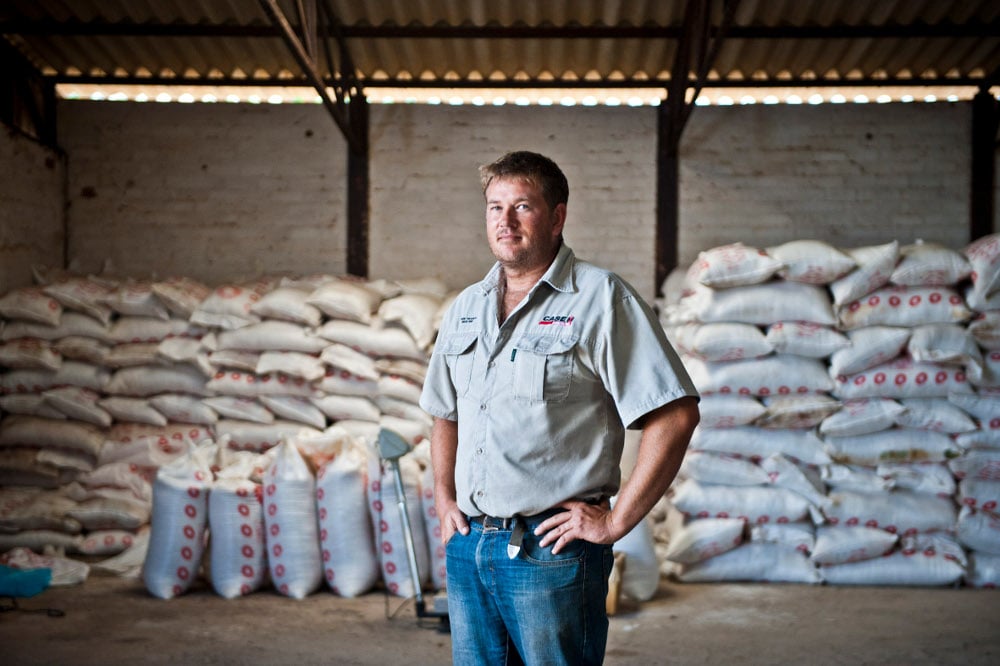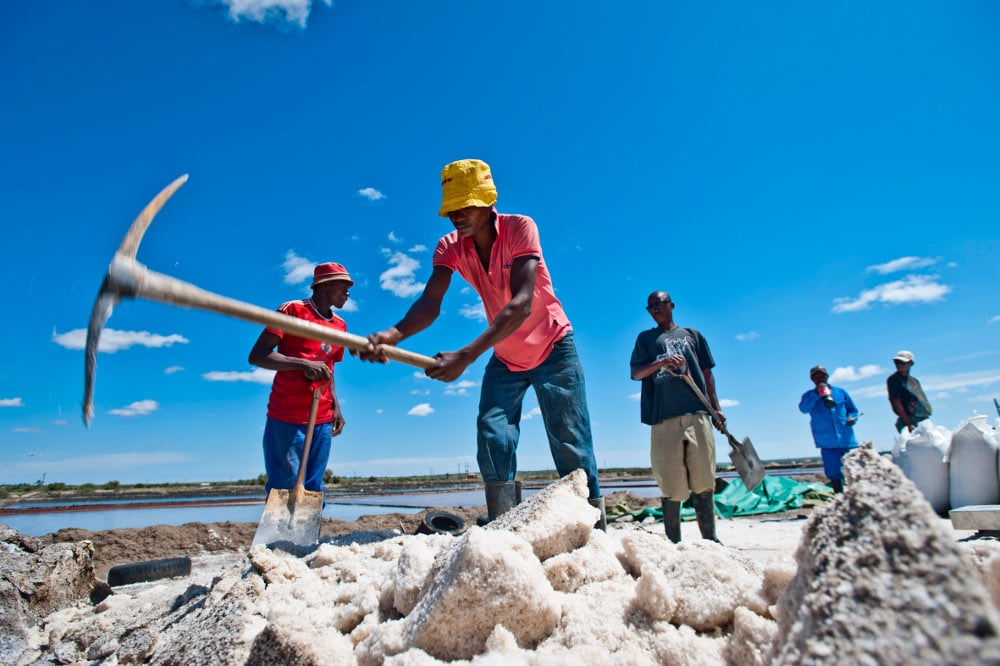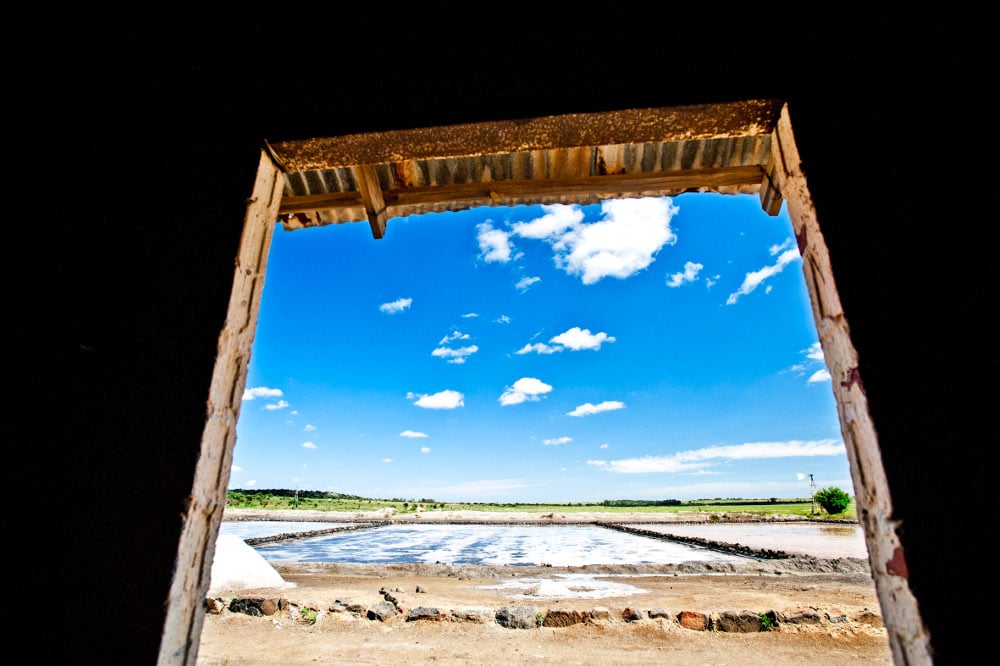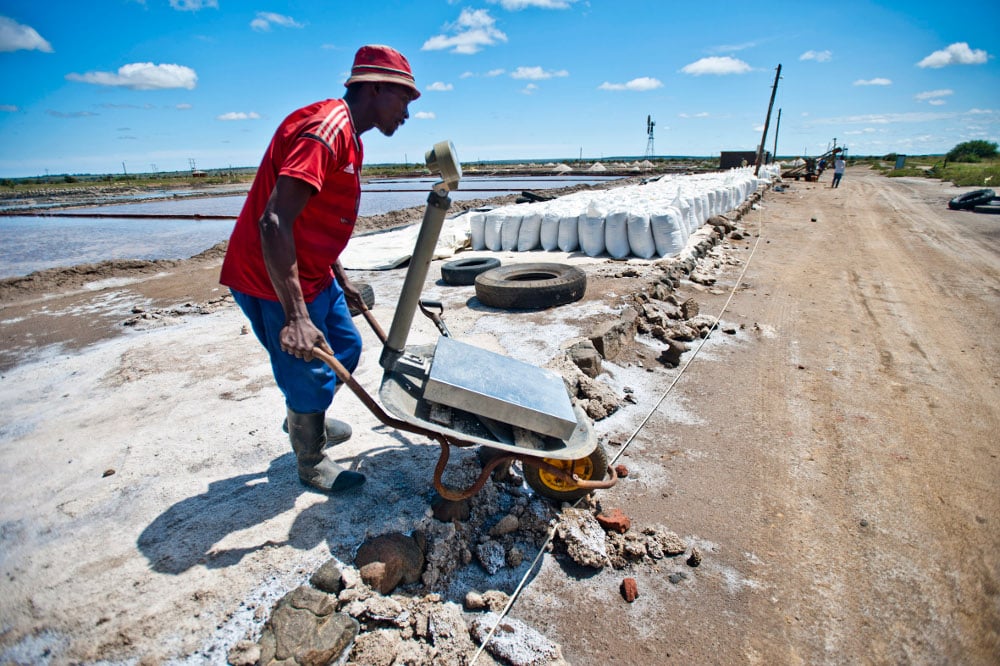Table grade salt requires milling and the addition of iodine.
The very first bite of pasta al pomodoro generously sprinkled with coarse sea salt is the moment I pinpoint as the end of my salt-sparing life.
From just a scattering on buttered bread to rubbing down a pork roast with it, or adding a heavy-handed dash of it to a rich chocolate mousse, salt is like the sun to blossoming taste buds and a vital addition to everything I sauté, roast, boil and bake.
Just a quick peek into my pantry will reveal the depth of my fixation. My collection ranges from normal table salt produced from the vast deposits that rest beneath the parched Kalahari Desert to geometrically shaped Mediterranean sea salt crystals sourced from the turquoise waters of Cyprus. It even boasts a grinder of pastel pink Himalayan rock salt from Khewra, Pakistan’s oldest salt mine and the second largest in the world, which, it is said, was discovered in 326BCE by Alexander the Great’s horses, which took to licking the rocks there.
In truth, I’m a salt addict, but I take comfort in knowing it’s an affliction I share with countless others.
Some vices are developed over time, but an attraction to salt is innate. Its addition to our diets is vital for our bodies, so vital, in fact, that, without it, your heart would stop.
The word itself says as much. The Roman word for salt crystals, sal, is derived from Salus, the goddess of health. The word salary, too, comes from when Roman soldiers were paid their wages in salt, which would be cut if it was decided that he was “not worth his salt”.
But human consumption is just one of thousands of uses for salt –sodium chloride – which is found in anything from food to soap and plastic and most in demand for its countless industrial applications.
Warfare, too, has found a use for the stuff. Salt is used in the manufacture of one of the most horrific weapons of war: chlorine gas. And it was in the pursuit of this that South Africa’s salt industry was born – for possible use in World War II.
Once as costly as gold, the price of salt dropped with increased production around the world and today its price comes nowhere close to reflecting its true value – something I had to find out for myself.
Mr Salt
It’s a warm autumn afternoon in Alberton as I follow the powerlines that stretch along the industrial suburb of Alrode.
I arrive at the premises of Sun Salt Services where I’m ushered into a room filled with a grandiose boardroom table, and not much else. The company manager, Colin Rodel, a neatly dressed and thoughtfully spoken man, introduces me to Nigel Sutherland, Mr Salt South Africa.
Sutherland has been involved solely in the salt business since the 1950s. He has a wealth of knowledge on the industry that he has watched change significantly throughout his lifetime. Eighty-eight years of age, he now walks with the help of two crutches and tolerates a persistent shake – a notable nuisance as he brings a cup of coffee to his lips. Hard of hearing, he reminds Rodel to speak up as he fills me in on the details of the family business.
Sun Salt packs the mineral compound at these premises in the south of Johannesburg, where it has been based for 20 years.
Sutherland’s son Brian runs the business, and his grandson Neil manages the factory.
But the Sutherlands’ involvement with salt goes back to 1940, with the intention of producing salt for more sinister applications than can be found at the dinner table.
“The fact is that, during World War?II, the South African government department of defence recruited three or four guys, one of which was my father, to research all known salt deposits in South Africa and estimate what reserves there were,” Sutherland says.
Weapon of war
He shuts his eyes tightly, drawing down his woolly white eyebrows, as he rummages through his extensive memory for just the right details.
“Right then, they were still talking about using poison gas – it was forbidden, it was anti the Geneva Protocol, it wasn’t going to be used – but nevertheless there was talk about it.”
Sutherland, whose father was a captain and instructed by military intelligence, explains it as if it is the most obvious thing in the world.
“Salt was the raw material, that’s it. Half of salt is chlorine and that is where they were going to get it from.”

Piet Cronje produces salt on a farm in Soutpan that has been passed down from generation to generation. (Photos: Delwyn Verasamy, M&G)
Chlorine gas was used in World War I and brought a horrific end to the lives of many soldiers. The chlorine reacts with water in the lungs, forming hydrochloric acid, which destroys them, leading to a slow death by asphyxiation. More recently, in war-torn Syria, the government is suspected to have used it to kill its own people, including children.
But World War II ended in 1945, before the commercial production of salt in South Africa took off.
“I know that Klipfontein Organic Products could make it [chlorine gas],” says Sutherland. “They did get salt, but I don’t believe that they ever made … er … well …”
Rodel says: “There is still a lot of secrecy of what was and wasn’t used.”
Back then, Sutherland’s father travelled throughout South Africa and other parts of the region to assess the salt reserves.
After the war he bought a share in a salt pan in Deelfontein in the Northern Cape but died before it went into production.
Sutherland took on the management of his father’s salt pan and set out to transform the potential resource into an economically viable reserve. He was so successful that other producers in the area employed his services to manage their deposits.
This was the platform from which South Africa’s salt industry was launched and Sutherland was at the centre of it.
Local industry
South Africa today has 26 operating salt companies of varying size and the local market is relatively competitive. Sun Salt packs more than 100 000 tonnes of salt each year.
In 2011, world production was nearing 300 megatonnes, with South Africa accounting for 0.00125% of the total production that year. Recently China has taken over from the United States as the biggest producer of salt, accounting for about 22%. The US follows at 16% and Germany and India contribute 7% and 6% respectively.
The government says the local industry’s sales amounted to R140.6-million in 2011 (which is really not much considering it’s the same amount the Free State notoriously spent on its website last year, and less than what the fynbos flower industry generates each year), with the majority of inland pans located in the Karoo Sequence, in a curved belt between 50km and 60km wide, which extends from near Vryburg in the North West to Hopetown on the eastern border of the Northern Cape.
Near the aptly named town of Soutpan, 50km outside Bloemfontein, you would be forgiven for thinking you were in the Wild West. A tumble-weed would not be out of place in the vast flat landscape dotted by rusty old windmills, where ground squirrels scurry on and off of the dirt road as my car draws near.
Piet Cronje, a burly man of 34 with russet hair and a ready smile, grew up in Soutpan, where he produces some of the purest salt in the area from the same land from which his father and grandfather produced it.
He is drawing on a cigarette as I arrive. He is wearing what you might expect of a young farmer in the Free State – denim jeans, dirty boots and a khaki shirt. What you would not expect, however, is the distinct American twang he acquired while working for many years on combine harvesters in the US.
Naturally occurring brine
Beneath the arid ground is naturally occurring brine, which is suitable for salt production. But the process requires the right conditions.
“We actually only just started producing again. We had a bunch of rain this summer. So this is probably the first harvest we take off,” Cronje explains. “The underground water should be supplied by rain. If it’s too dry, we don’t have water; if it’s too wet, we can’t do anything.”
Peak production here starts after winter until December and, at the height of it, crews will work day and night, under spotlights, to harvest the mineral substance.

The harvesting of salt is dependent on weather conditions – it must not be too dry or too wet.
There are several boreholes on Cronje’s property from which the salty underground brine is pumped out and transferred into a storage dam, where the water is left to evaporate until it reaches a salt concentration of up to 55%. It is then pumped to the evaporation ponds, from where, after reaching close to 100% concentration, it is moved to crystallisation ponds.
Today they are white and resemble ice rinks. Two workers harvest the salt by hand with ploughs fashioned out of wooden pitchfork handles and stainless steel plating.
When the salt is harvested, it is heaped alongside the pans where it dries in the searing sun and is then bagged.
How does he know when it is ready?
“You just feel it, I guess.”
He looks down at his hand full of course white salt. It feels a bit damp to me, but he assures me that it’s ready for bagging.
Co-operative
The salt from his farm and 14 other producers in the co-operative, SA Sout Koöperasie, is used largely for mixing into animal feed and is sold to feedlots and farmers. The co-op is a mid-level salt producer in South Africa and dwarfed when compared with the likes of Cerebos.
With a purity level of 99.9%, much of Cronje’s production is considered grade one salt – although some of his output is also grade two. Salt can range in quality from grade one to grade four, depending on how many impurities are in it, which can be indicated by its shade, which varies from the purest white to that with a hint of beige or grey.
Some producers charge nearly R80 for a 50kg bag of refined, food grade salt. Cronje’s business produces about 1 000 bags a week, which he sells for about R24 a 50kg bag, depending on the grade. His input costs are about R12 a bag, resulting in a profit margin of about 50%. “Most of the guys produce 1 000 bags a month. That will probably give you turnover of R23 000 a month, but then in your pocket you will probably only have R10 000, R12 000 …”
The department of mineral resources says local sales have been rising at an average rate of 6.83% a year in the past decade because of growing demand and increasing salt prices, but salt producers say input costs continue to chew into the margins.
“Most of the guys around here are smaller guys and probably 60-plus. You know, the Eskom bills, wages and everything is kinda killing them, so they’re all dying out … I think it’s getting too expensive,” Cronje says. “There is so much land laying here, people don’t wanna do salt. People say it’s too much effort, not enough money.”
Mineral laws
Defined as a mineral under South African law and governed by the Mineral and Petroleum Resources Development Act, salt producers should comply with its requirements as mining houses do, including black economic empowerment, social and labour plans and rehabilitation.
According to the department, mining rights require a comprehensive application that should include a geological report, details of the market, social and labour plans, royalty payments, evidence of detailed financial and technical competence, and an environmental management plan. Mining permits, on the other hand, require very basic information on financial and technical competence and environmental management, but they restrict the area mined to 1.5 hectares and proof that the mineral can be mined optimally within two years.

A view of the Soutpan salt pan from a shed storing tools and implements.
“None of us are licensed,” says Cronje, noting that the members of the co-operative had applied for mining rights in order to be compliant but, because of the costs involved, have fallen short. “We have tried, but we are declined every time. The social and labour plans were the biggest issue. We don’t meet the criteria.”
But other regulations have also created barriers to entry and, in the case of iodisation requirements, have stopped salt producers like Cronje from supplying food grade salt.
“We used to, back in the day we did a lot of fine salts. We had a lot of state contracts. You know, we did hospitals and armies and all that, but, when the iodine came in, we stopped milling.”
Iodine addition
Professor Pieter Jooste, now retired from his post as chief specialist scientist and director of the national intervention research unit at the Medical Research Council (MRC), was instrumental in the introduction of the compulsory addition of iodine to table salt, which is now regulated by law for all food grade salt.
He is the regional co-ordinator for Southern African countries of the International Council for Control of Iodine Deficiency Disorders.
The MRC, Jooste says, was crucial in identifying the problem of persistent endemic goitre and iodine deficiency in South Africa, despite earlier regulation calling for producers to put iodine in their salt on a voluntary basis. Following reports in 1927 about endemic goitre, an abnormally enlarged thyroid gland, voluntary salt iodisation at a low concentration of 10 to 20 parts per million was instituted in 1954.
On the back of some external and political expectations, revised regulations about the mandatory iodisation of food grade salt were developed and implemented in 1995 and revised a decade later to increase the iodisation to between 35 and 65 parts per million.
There are many iodine deficiency disorders, including child mortality, reproductive failure and cretinism. The introduction of iodine into salt has virtually eradicated cretinism, which was pervasive in many nations. One hundred and fifty of the 193 World Health Organisation member nations have salt iodisation programmes.
Imported brands, such as the pricey Maldon salt, don’t contain iodine, but “wealthy people who can afford that probably don’t have an iodine deficiency”, Jooste says.
Integral ingredient
You won’t always find salt on the tables at Coobs, a popular bistro in Johannesburg’s Parkhurst. But don’t be fooled into thinking salt is taboo here – the kitchen goes through about 10kg of the stuff every week.
The restaurant opened its doors in 2012 and impressively made it into the Eat Out 500 list in its first year. For Coobs chef and founder James Diack, salt is an integral part of his nose-to-tail cuisine.
In a quiet corner of the tapas bar, Diack shows me his salt library – a collection of unusual salts from around the world. We start with salt caviar, small white pearls, from the Kalahari, before moving on to a pink desert salt and finishing off with black lava salt from Hawaii.
I nod in agreement to his observations about the flavours as I try not to let on how my taste buds are suffering and casually sweep substantial amounts of salt off my hand on to a saucer.
“We use, as much as possible, raw salt. Your noniodised, your proper big clumps of salt.”

Coobs chef and founder James Diack, uses as much as possible raw salt for his nose-to-tail cuisine.
The salt is sourced from “the most random places”, like food preserving operations. And his mother, who runs a farm, even gets it from the co-operative, which buys it for mixing into animal feed.
Otherwise, “we use anything from fleur de sel to Maldon, to normal fine salt.”
Recently he also bought a shaker of pink salt because a pig leg cured in rum and molasses “called for it”.
Kitchen workhorse
“Salt has an amazing potential to pull out all your unwanteds, like the gaminess of ducks. It almost adds to the gaminess because it pulls out the impurities. It almost pulls out what you don’t want, or enhances what you do.”
The coarse salt is undoubtedly the workhorse in the kitchen and used for gravlax, pork belly rubs, duck confit and salting pasta water.
“People can’t understand when they taste our food why it tastes different,” Diack says. “I put it down to the minerality of raw salt. It doesn’t linger, it gives flavour, it does its task and then it fucks off.”
But the food industry only consumes 30% of the world’s salt production each year. The largest user by far is the industrial sector, which uses the mineral in processes such as petrol refining, petrochemistry, and even glass production. The balance is used for road de-icing, water treatment, the production of cooling brines and other smaller applications.
In South Africa, the chemicals industry is the biggest user, accounting for about 54% of the total consumption. Sasol, for example, uses about 250 000 tonnes of salt each year at its chlorine-alkali plant in Sasolburg.
“What we really want is the chlorine from that salt. We use an electrolysis process to split sodium and chlorine into a gas to use in plastics like polyvinyl chloride – a hard plastic known as PVC,” says Sarushen Pillay, the environmental technology manager of Sasol technology. This polymer is sold as small pellets.
Salt sales
The department of mineral resources says local salt sales have increased at an annual average rate of 1.56% in the past decade because of growth in the chemical sector.
But the biggest users in South Africa, such as Sasol and NCP Chlorchem, buy salt mainly from two producers: Botswana Ash, a soda ash producer, which makes salt as a by-product, and Walvis Bay Salt. And it’s a thorn in the side for local suppliers. Even the biggest salt producers, such as Donald Brown, import a great deal of salt as a result of rising input costs.
“We buy salt cheaper from Walvis Bay and [have it delivered to Cape Town by ship] than we can supply locally,” sales director Clifford Retief says.

When conditions in Soutpan are right, underground brine is pumped to the surface and processed.
Neil Sutherland, Nigel’s grandson, agrees. “It becomes very expensive to produce food grade salt in South Africa as one has to comply with all the regulatory aspects. But your price is always compared to fly-by-night operators and uncontrolled imports, which all tend to the cheaper side, and so one gets continual resistance to a proposed realistic and sustainable price.
“People buy salt without realising what effort goes into producing it and a lot of the consumers do not or cannot pay more than the cheapest brand out there.”
Prime real estate
Rodel believes production sites on the coast could start feeling the pinch soon as it is prime real estate.
“As for the inland salt producers, the life of the deposit is finite and it will run out. So in 50 or so years, South Africa will become a net importer of salt and will have little prospect of changing that due to new and more extraneous laws imposed on the mining sector.”
The department sees things differently. Although salt production started declining in 2008 because of increased rainfall and the world economic recession, there are still “abundant salt reserves in the country, as well as growing demand, which is consistent with the levels of economic growth”, the department states in a recent report. “Small-scale miners are therefore encouraged to seize the opportunity to enter this market, particularly as South Africa imports approximately 50% of salt to meet its chemical industry demand levels.”
I had always wondered about a famous quote by Nelson Mandela, who said: “Let there be justice for all. Let there be peace for all. Let there be work, bread, water and salt for all.”
Justice and peace, of course. Work, bread, and water – a given. But, salt? How peculiar, I had always thought.
Of course, now I know it is not.
Although, in my house, it may be commonly used to enhance flavour or even to decorate golden, crunchy potato wedges, that same salt is transported to countries such as the impoverished Democratic Republic of Congo, where, because refrigeration is a luxury, it is vital to preserve fish and other foodstuffs.
Because of its negligible financial cost, it is all too easy forget the real value this life-giving mineral, which, as Mandela suggested, is part and parcel of the most basic of human rights.
Study finds a sweetener for salt lovers
Although there is general consensus in the medical world that too much salt is bad for you, there is an ongoing debate about how much is too much – and new research suggests that people who ingest too little are paying a high price.
According to Christelle Crickmore, the science and programme development manager at the Heart and Stroke Foundation, “some salt is needed … but too much salt increases your blood pressure, which is the leading cause of heart disease and stroke in South Africa.
“The recommended amount is five grams [that is equal to 2 000mg of sodium] per day. We know that South Africans consume more than that [and] we know that above five grams a day does increase the blood pressure. If you look at the bulk of evidence, that would be the international consensus, that hypertension is a key risk for heart attacks and for strokes.”
That’s what prompted Minister of Health Aaron Motsoaledi to sign off on new salt regulations in March 2013, which will see the sodium content in many foods reduced.
Globally, salt intake is too high, according to the World Health Organisation’s data on global sodium consumption, which shows that average national consumption rates range from 2 700mg in Germany to 7 200mg in Turkey.
Health authorities recommend that people restrict sodium intake to less than 2 000mg to 2 300mg a day, but average sodium consumption exceeds these upper limits by 25% to 70%, depending on the country. In South Africa, average salt intake is between 3 000mg and 4 000mg a day.
A Canadian-led study, published in the New England Journal of Medicine in August last year, found that, when it comes to salt consumption, there is a sweet spot and, if it’s to be believed, South Africans have found it.
In studying 100 000 people using salt over a period of four years, researchers at McMaster University and Hamilton Health Sciences discovered that a sodium level of more than five grams a day does indeed raise blood pressure, but not in cases in which a person consumed an “average level” of between three and five grams a day.
Furthermore, the research found that those who consume less than average amounts have an elevated risk of heart attack, strokes and other cardiovascular problems.